14 – 19 AUGUST 2023
By Andrew Walker
Overview
This Papua New Guinea birding tour focused on the province of New Britain, the largest island in the Bismarck Archipelago. The tour started in Port Moresby on the 14th of August 2023 and ended back there on the 19th of August 2023. During this New Britain birding tour, we spent the duration of our stay on the island at the excellent and luxurious Walindi Plantation (Dive) Resort, a wonderful base for local birding excursions. Our birding was focused on the endemic birds of New Britain, along with several Bismarck Archipelago and Solomon Islands regional endemics. The weather was unseasonably wet during our tour, and we lost valuable birding time because of this; however, we still managed to find a high number of the most-wanted species thanks to the help of our excellent local guiding team.
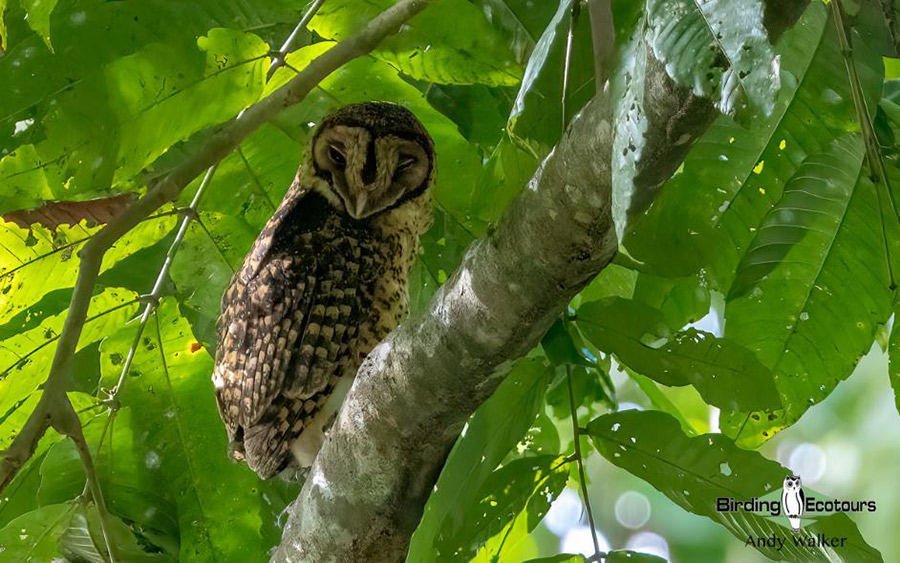
The rare New Britain endemic Golden Masked Owl was a highlight on our New Britain birding tour; we enjoyed great views of this highly sought-after species, known from very few sites.
We recorded 93 species on the tour (two of these heard only). Trip lists follow the report. The list of highlights was very long and included Melanesian Megapode, Red-knobbed Imperial Pigeon, Yellowish Imperial Pigeon, Island Imperial Pigeon, Finsch’s Imperial Pigeon, Nicobar Pigeon, Knob-billed Fruit Dove, MacKinlay’s Cuckoo-Dove, Blue-eyed Cockatoo, Singing Parrot, Purple-bellied Lory, Bismarck Hanging Parrot, Buff-faced Pygmy Parrot, White-necked Coucal, Violaceous Coucal, Blyth’s Hornbill, Golden Masked Owl, New Britain Boobook, Black-capped Paradise Kingfisher, New Britain Dwarf Kingfisher, White-mantled Kingfisher, Melanesian Kingfisher, Beach Kingfisher, Bismarck Pitta (New Britain Pitta), Bismarck Crow, Spangled (Bismarck) Drongo, New Britain Friarbird, Sclater’s Myzomela, Black-bellied Myzomela, Ashy Myzomela, Black-tailed Monarch, Velvet Flycatcher, Long-tailed Myna, Red-banded Flowerpecker, and Buff-bellied Mannikin. Two Wood Sandpipers in a flooded field were a surprise find and were vagrants to New Britain.
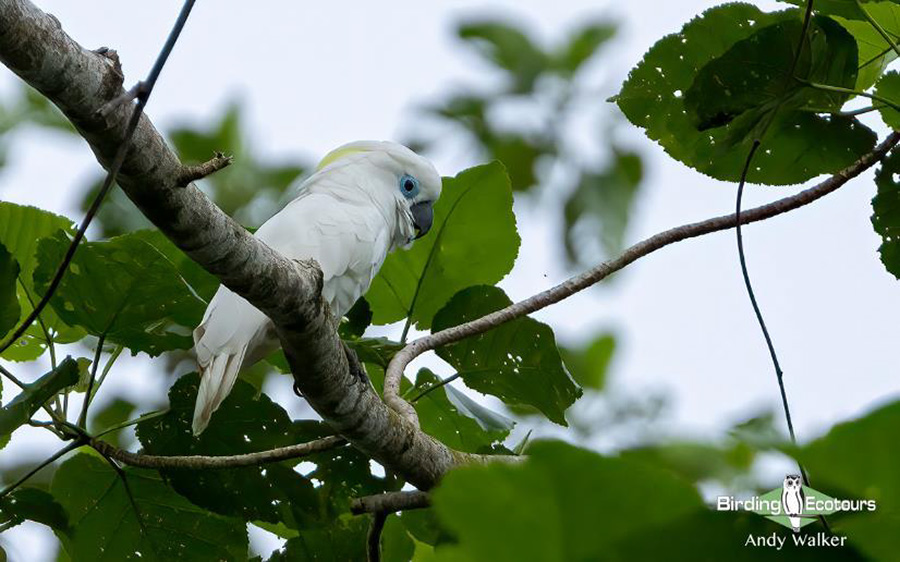
The uncommon New Britain endemic, Blue-eyed Cockatoo, showed well during our New Britain birding tour.
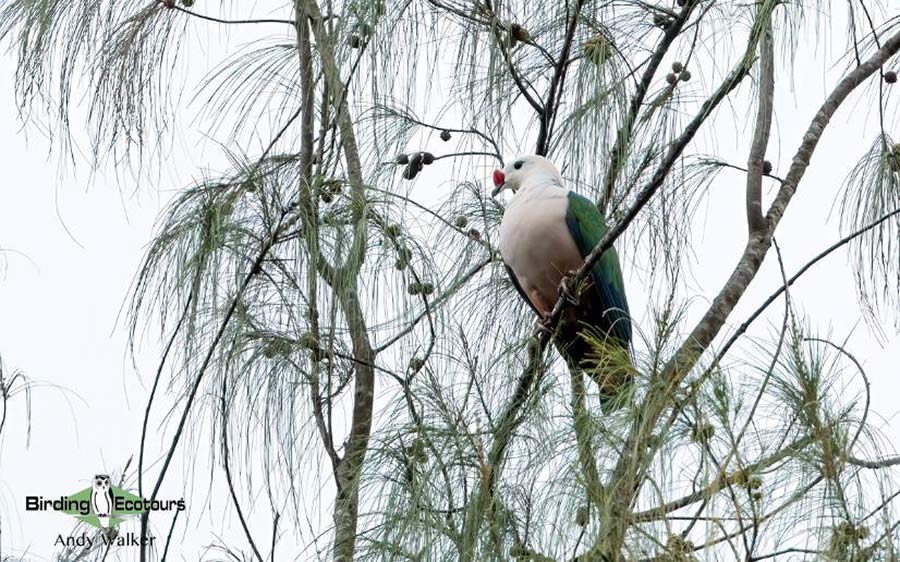
The impressive-looking Red-knobbed Imperial Pigeon was commonly seen and heard in the resort gardens along with many other great birds.
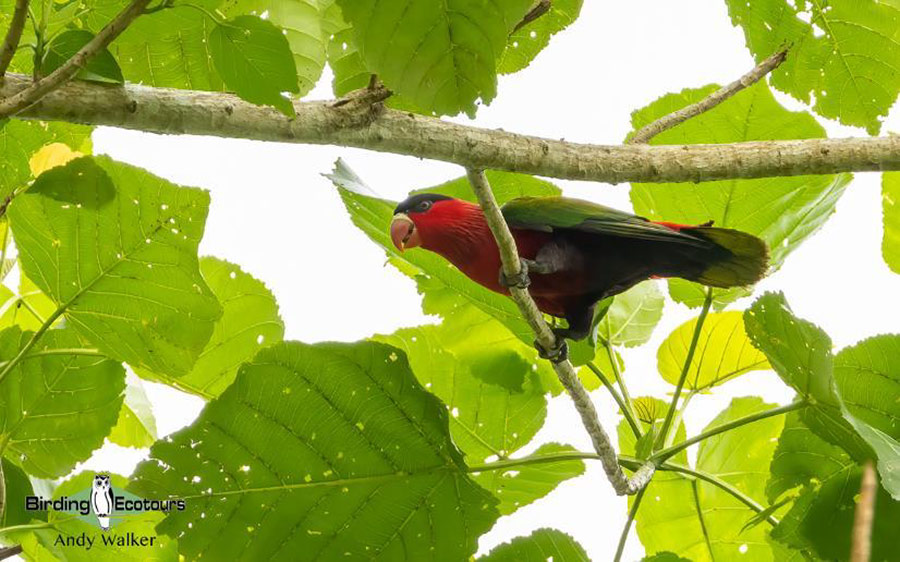
We had great looks at Purple-bellied Lory on many occasions during the New Britain birding tour, and it was another stunning bird found around the rooms in our resort.
Detailed Report
Day 1, 14th August 2023. Arrival in Port Moresby
An arrival day in Port Moresby. We enjoyed our welcome dinner together and discussed what we were hoping to see on this New Britain birding tour.
Day 2, 15th August 2023. Flight between Port Moresby and Hoskins, New Britain, travel to and birding at Walindi Plantation (Dive) Resort
After breakfast in our very comfortable hotel in Port Moresby, we took a mid-morning flight from Port Moresby to Hoskins on the island of New Britain (via the city of Lae). We arrived at a rainy Hoskins Airport around noon and made the drive across to Walindi Plantation (Dive) Resort in time for a late lunch.
We spent the late afternoon dodging light rain showers and started our birding with some relaxed exploration of our dive resort grounds. The number of birds was impressive and included some great species in the trees around the rooms, including Red-knobbed Imperial Pigeon, Moustached Treeswift, Papuan Eclectus, Purple-bellied Lory, Bismarck Crow, Varied Triller, New Britain Friarbird, Willie Wagtail, Metallic Starling, Black Sunbird, and Olive-backed Sunbird. The coastal strip, including a nice intertidal area, gave us views of Black Bittern, Little Egret, Great Egret, Eurasian Whimbrel, Common Sandpiper, Osprey, Brahminy Kite, Common Kingfisher, and Sacred Kingfisher. As the afternoon progressed, the rain started to get more persistent and heavier, so we called time and prepared for dinner.
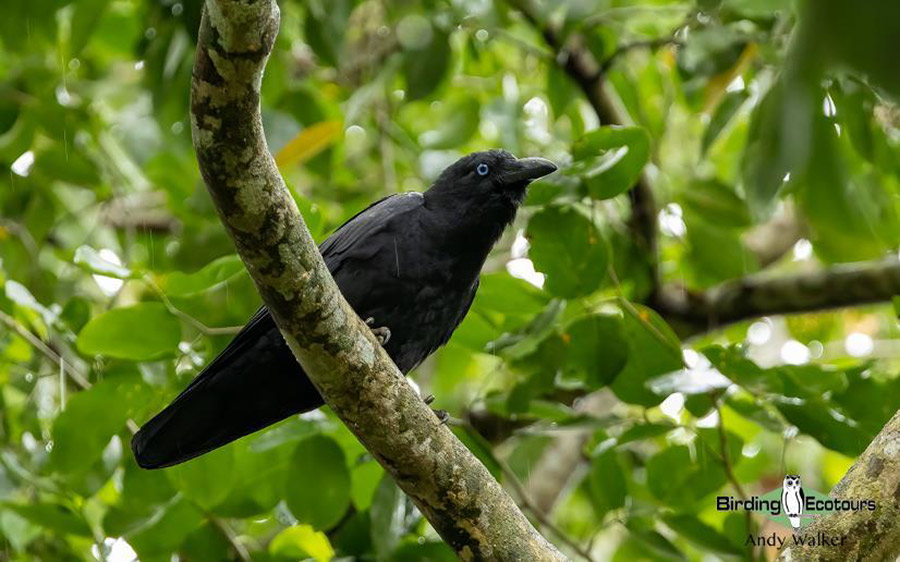
The regionally endemic Bismarck Crow was abundant in the resort grounds.
Day 3, 16th August 2023. Birding Kulu River
The rain that had been falling since our arrival in New Britain yesterday, continued all night and all of this morning too, which really ruined our morning birding session. Instead of being able to walk around, we drove some increasingly waterlogged back roads, found a few targets, and tried to make the most of the awful (and out of season) rainy conditions. Black Bitterns, Nankeen Night Herons, and Pacific Black Ducks were numerous (including the unusual sight of an albino Black Bittern!). Along the roads, we also found several Red-knobbed Imperial Pigeons, Stephan’s Emerald Doves, Melanesian Kingfishers, Coconut Lorikeets, Rainbow Bee-eaters, and Buff-bellied Mannikins. The biggest surprise was finding two Wood Sandpipers in a flooded field, a vagrant to New Britain. We called in at some grassland where we found more Buff-bellied Mannikins, Australian Reed Warbler, Papuan Grassbird, Golden-headed Cisticola, Swinhoe’s Snipe, and a family group of Buff-banded Rails.
Thankfully, the weather improved for our afternoon birding session, and we were rewarded with some great birds and excellent sightings of many of them. As well as most of the birds we’d found in the morning, some of the other highlights included Blue-eyed Cockatoo, Purple-bellied Lory, Bismarck Hanging Parrot, New Britain Boobook, Yellowish Imperial Pigeon, Amboyna Cuckoo-Dove, White-necked Coucal, Violaceous Coucal, Blyth’s Hornbill, White-rumped Swiftlet, Long-tailed Myna, Spangled (Bismarck) Drongo, Northern Fantail, and as dusk approached, a brief Melanesian Megapode.
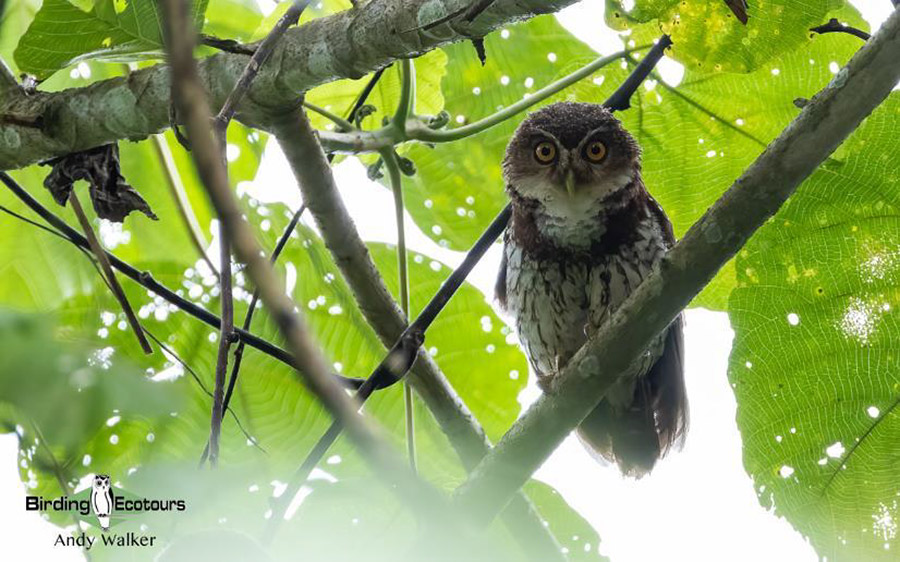
We had a nice surprise finding a pair of New Britain Boobooks in the late afternoon.
Day 4, 17th August 2023. Birding Kimbe Bay and Walindi Plantation Resort area
We spent the morning exploring Kimbe Bay by boat, a fantastic way to see this beautiful area. Birds were plentiful, and we checked out Restorf Island, Small Malumalu Island, and Large Malumalu Island. The most dominant bird was Island Imperial Pigeon, a species present in large numbers, with their call echoing all around us. We briefly glimpsed two Nicobar Pigeons and also found Mackinlay’s Cuckoo-Dove, Yellowish Imperial Pigeon, and Stephan’s Emerald Dove. Beach Kingfisher provided another highlight, with both Melanesian Kingfisher and Sacred Kingfisher also recorded. Small birds noted on the islands included Sclater’s Myzomela, Ashy Myzomela, Mangrove Golden Whistler, Island Monarch, Shining Flycatcher, and Metallic Starling. Gorgeous Rainbow Bee-eaters were overhead, as were Brahminy Kite and Osprey. On the water and exposed reefs (when the tide receded), we found Pacific Reef Heron, Lesser Frigatebird, Black-naped Tern, Common Tern, Greater Crested Tern, and Black Noddy. Most of the group spent some time snorkeling at one of the reefs, with rave reviews of the stunning fish life and coral present.
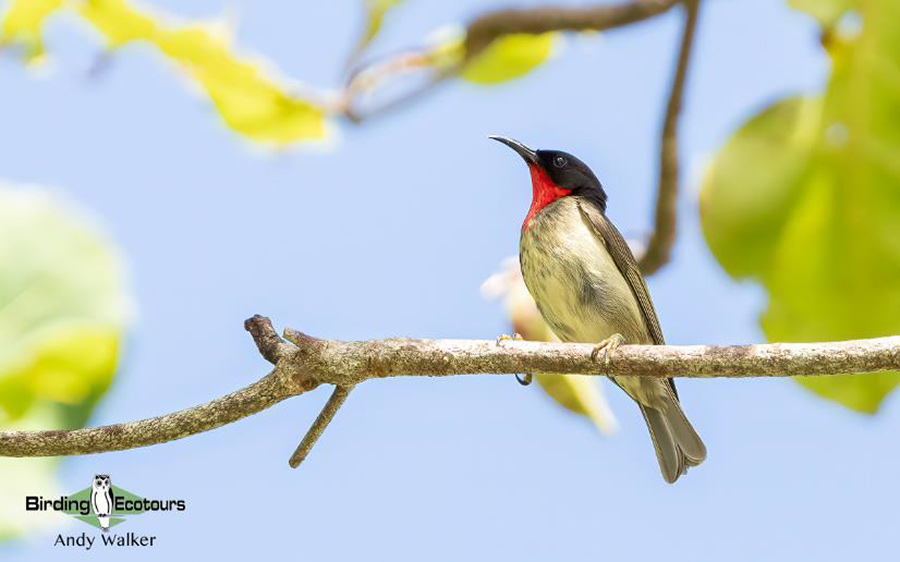
The pretty Sclater’s Myzomela eventually showed well after lots of brief and flighty views.
During the afternoon, some interesting birds were spotted around the resort grounds, including Oriental Hobby, New Britain Friarbird, and Buff-faced Pygmy Parrot. We took a drive to a nearby village, where we found one of the top targets of the tour, the rare Golden Masked Owl (see trip report cover image). We had excellent views of a roosting bird, a real tour highlight. After that, we explored a small patch of forest, where we had Black-capped Paradise Kingfisher; though heard by all, it was only seen by a couple of people, so we would need to hope for a further opportunity the following day for others to get a sight of this beautiful bird. Here, we also found Blyth’s Hornbill, Blue-eyed Cockatoo, Papuan Eclectus, Purple-bellied Lory, Yellowish Imperial Pigeon, Red-knobbed Imperial Pigeon, Long-tailed Myna, and Forest Kingfisher.
Day 5, 18th August 2023. Birding Garu Wildlife Management Area and Kulu River
We spent most of the day birding at Garu Wildlife Management Area. Again, we had to deal with rain, which persisted for most of the morning, and the bird activity was down because of it, especially during the first few hours of the day. We found several new birds (or improved our views of previously seen species) when conditions improved, and these included Melanesian Megapode, Black-capped Paradise Kingfisher, and White-mantled Kingfisher. A flowering tree was busy with a noisy flock of Red-flanked Lorikeets, along with a couple of Ashy Myzomelas and Black-bellied Myzomelas. Nearby, a huge tree was full of Buff-faced Pygmy Parrots, though they were extremely tough to see as they were just so tiny! Other species like Blue-eyed Cockatoo, Papuan Eclectus, Purple-bellied Lory, Long-tailed Myna, Black-tailed Monarch, Northern Fantail, Varied Triller, Knob-billed Fruit Dove, Red-knobbed Imperial Pigeon, and Finsch’s Imperial Pigeon, were also seen.
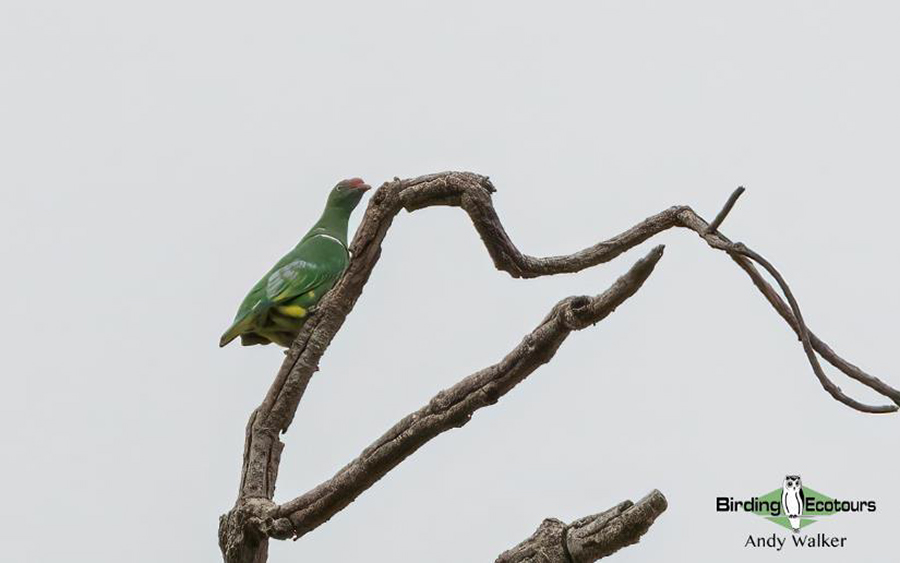
Knob-billed Fruit Dove is endemic to the Bismarck Archipelago.
As we wandered along various sections of the road through the management area, we found Blyth’s Hornbill, Red-banded Flowerpecker, Slaty-mantled Goshawk, Variable Goshawk, Superb Fruit Dove, White-necked Coucal, New Britain Dwarf Kingfisher, Singing Parrot, White-bellied Cuckooshrike, Spangled (Bismarck) Drongo, Velvet Flycatcher, Bismarck Crow, Black Sunbird, and more.
In the mid-afternoon, we called back to the Kulu River area, where we spent a couple of hours stalking a Bismarck Pitta (New Britain Pitta). It was seen by some, but unfortunately, not all of the group. Their shyness and preference for dense forests make them tough birds to connect with.
Day 6, 19th August 2023. Departure from Hoskins, New Britain
After a final breakfast at the delightful Walindi Plantation Resort, we traveled to Hoskins Airport and took our flight back to Port Moresby, where this short New Britain birding tour ended.
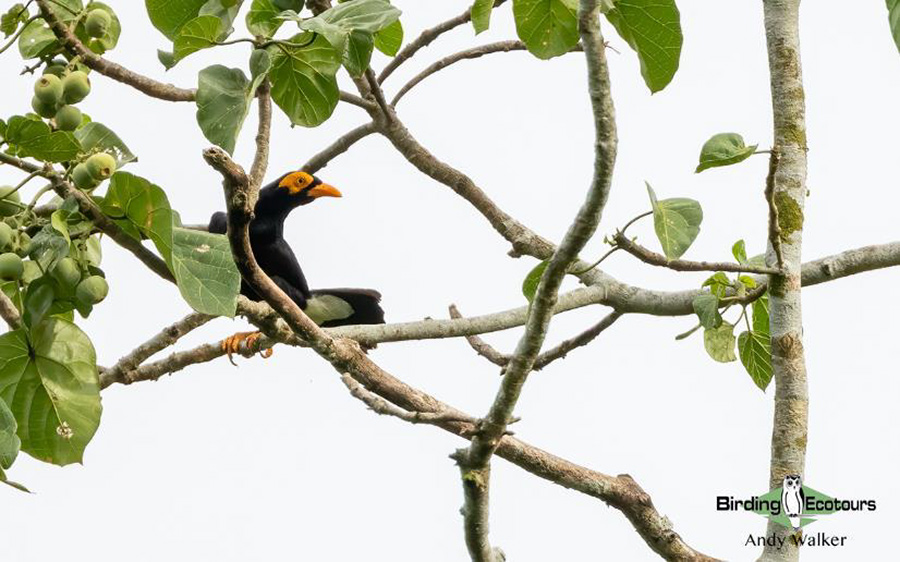
Long-tailed Myna was common but often high in fruiting trees.
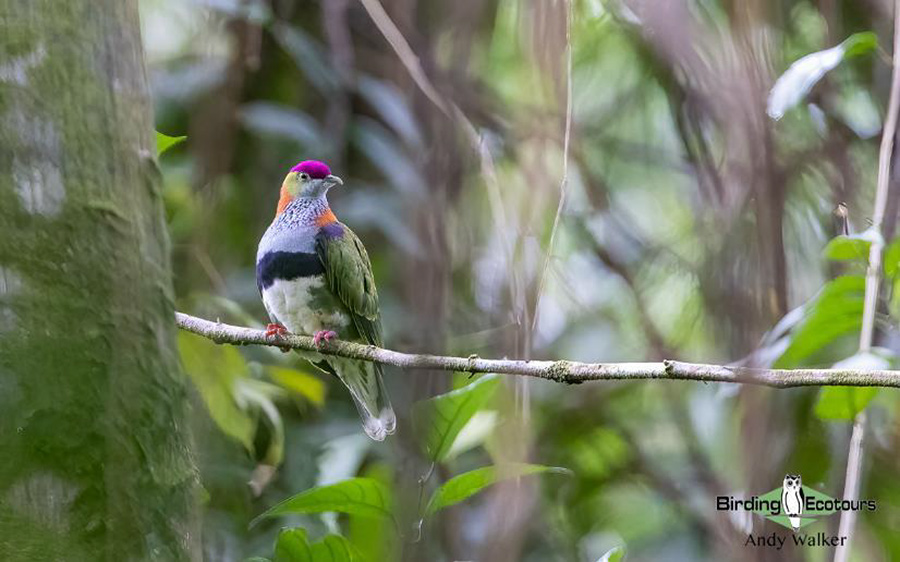
Although widespread, Superb Fruit Dove is one spectacular species and always nice to see.
Bird List – Following IOC (13.2)
Birds ‘heard only’ are marked with (H) after the common name, all other species were seen. The following notation after species names is used to show conservation status following BirdLife International: VU = Vulnerable.
| Common Name | Scientific Name |
| Ducks, Geese, Swans (Anatidae) | |
| Pacific Black Duck | Anas superciliosa |
| Megapodes (Megapodiidae) | |
| Melanesian Megapode | Megapodius eremita |
| Pheasants & Allies (Phasianidae) | |
| King Quail (H) | Synoicus chinensis |
| Treeswifts (Hemiprocnidae) | |
| Moustached Treeswift | Hemiprocne mystacea |
| Swifts (Apodidae) | |
| Glossy Swiftlet | Collocalia esculenta |
| White-rumped Swiftlet | Aerodramus spodiopygius |
| Uniform Swiftlet | Aerodramus vanikorensis |
| Cuckoos (Cuculidae) | |
| White-necked Coucal | Centropus ateralbus |
| Violaceous Coucal | Centropus violaceus |
| Shining Bronze Cuckoo (H) | Chrysococcyx lucidus |
| Brush Cuckoo | Cacomantis variolosus |
| Pigeons, Doves (Columbidae) | |
| Amboyna Cuckoo-Dove | Macropygia amboinensis |
| MacKinlay’s Cuckoo-Dove | Macropygia mackinlayi |
| Pied Cuckoo-Dove | Reinwardtoena browni |
| Stephan’s Emerald Dove | Chalcophaps stephani |
| Nicobar Pigeon | Caloenas nicobarica |
| Superb Fruit Dove | Ptilinopus superbus |
| Knob-billed Fruit Dove | Ptilinopus insolitus |
| Red-knobbed Imperial Pigeon | Ducula rubricera |
| Finsch’s Imperial Pigeon | Ducula finschii |
| Island Imperial Pigeon | Ducula pistrinaria |
| Yellowish Imperial Pigeon | Ducula subflavescens |
| Rails, Crakes & Coots (Rallidae) | |
| Buff-banded Rail | Hypotaenidia philippensis |
| Sandpipers, Snipes (Scolopacidae) | |
| Eurasian Whimbrel | Numenius phaeopus |
| Swinhoe’s Snipe | Gallinago megala |
| Common Sandpiper | Actitis hypoleucos |
| Wood Sandpiper | Tringa glareola |
| Gulls, Terns, Skimmers (Laridae) | |
| Black Noddy | Anous minutus |
| Greater Crested Tern | Thalasseus bergii |
| Black-naped Tern | Sterna sumatrana |
| Common Tern | Sterna hirundo |
| Frigatebirds (Fregatidae) | |
| Lesser Frigatebird | Fregata ariel |
| Cormorants, Shags (Phalacrocoracidae) | |
| Little Pied Cormorant | Microcarbo melanoleucos |
| Herons, Bitterns (Ardeidae) | |
| Black Bittern | Ixobrychus flavicollis |
| Nankeen Night Heron | Nycticorax caledonicus |
| Eastern Cattle Egret | Bubulcus coromandus |
| Great Egret | Ardea alba |
| Little Egret | Egretta garzetta |
| Pacific Reef Heron | Egretta sacra |
| Ospreys (Pandionidae) | |
| Osprey | Pandion haliaetus |
| Kites, Hawks, Eagles (Accipitridae) | |
| Variable Goshawk | Accipiter hiogaster |
| Slaty-mantled Goshawk – VU | Accipiter luteoschistaceus |
| Brahminy Kite | Haliastur indus |
| White-bellied Sea Eagle | Haliaeetus leucogaster |
| Barn Owls (Tytonidae) | |
| Golden Masked Owl – VU | Tyto aurantia |
| Owls (Strigidae) | |
| New Britain Boobook – VU | Ninox odiosa |
| Hornbills (Bucerotidae) | |
| Blyth’s Hornbill | Rhyticeros plicatus |
| Kingfishers (Alcedinidae) | |
| Black-capped Paradise Kingfisher | Tanysiptera nigriceps |
| Forest Kingfisher | Todiramphus macleayii |
| White-mantled Kingfisher | Todiramphus albonotatus |
| Melanesian Kingfisher | Todiramphus tristrami |
| Beach Kingfisher | Todiramphus saurophagus |
| Sacred Kingfisher | Todiramphus sanctus |
| Common Kingfisher | Alcedo atthis |
| New Britain Dwarf Kingfisher | Ceyx sacerdotis |
| Caracaras, Falcons (Falconidae) | |
| Oriental Hobby | Falco severus |
| Bee-eaters (Meropidae) | |
| Rainbow Bee-eater | Merops ornatus |
| Cockatoos (Cacatuidae) | |
| Blue-eyed Cockatoo – VU | Cacatua ophthalmica |
| Old World Parrots (Psittaculidae) | |
| Buff-faced Pygmy Parrot | Micropsitta pusio |
| Papuan Eclectus | Eclectus polychloros |
| Song Parrot | Geoffroyus heteroclitus |
| Red-flanked Lorikeet | Hypocharmosyna placentis |
| Purple-bellied Lory | Lorius hypoinochrous |
| Coconut Lorikeet | Trichoglossus haematodus |
| Bismarck Hanging Parrot | Loriculus tener |
| Pittas (Pittidae) | |
| Bismarck Pitta | Erythropitta novaehibernicae |
| Honeyeaters (Meliphagidae) | |
| Ashy Myzomela | Myzomela cineracea |
| Sclater’s Myzomela | Myzomela sclateri |
| Black-bellied Myzomela | Myzomela erythromelas |
| New Britain Friarbird | Philemon cockerelli |
| Cuckooshrikes (Campephagidae) | |
| White-bellied Cuckooshrike | Coracina papuensis |
| Varied Triller | Lalage leucomela |
| Whistlers & Allies (Pachycephalidae) | |
| Mangrove Golden Whistler | Pachycephala melanura |
| Drongos (Dicruridae) | |
| Spangled Drongo | Dicrurus bracteatus |
| Fantails (Rhipiduridae) | |
| Willie Wagtail | Rhipidura leucophrys |
| Northern Fantail | Rhipidura rufiventris |
| Monarchs (Monarchidae) | |
| Black-tailed Monarch | Symposiachrus verticalis |
| Island Monarch | Monarcha cinerascens |
| Shining Flycatcher | Myiagra alecto |
| Velvet Flycatcher | Myiagra eichhorni |
| Crows, Jays (Corvidae) | |
| Bismarck Crow | Corvus insularis |
| Swallows, Martins (Hirundinidae) | |
| Pacific Swallow | Hirundo tahitica |
| Reed Warblers & Allies (Acrocephalidae) | |
| Australian Reed Warbler | Acrocephalus australis |
| Grassbirds & Allies (Locustellidae) | |
| Papuan Grassbird | Cincloramphus macrurus |
| Cisticolas & Allies (Cisticolidae) | |
| Golden-headed Cisticola | Cisticola exilis |
| Starlings, Rhabdornises (Sturnidae) | |
| Metallic Starling | Aplonis metallica |
| Singing Starling | Aplonis cantoroides |
| Long-tailed Myna | Mino kreffti |
| Flowerpeckers (Dicaeidae) | |
| Red-banded Flowerpecker | Dicaeum eximium |
| Sunbirds (Nectariniidae) | |
| Black Sunbird | Leptocoma aspasia |
| Olive-backed Sunbird | Cinnyris jugularis |
| Old World Sparrows, Snowfinches (Passeridae) | |
| Eurasian Tree Sparrow | Passer montanus |
| Waxbills, Munias & Allies (Estrildidae) | |
| Buff-bellied Mannikin | Lonchura melaena |
| Total seen | 91 |
| Total heard only | 2 |
| Total recorded | 93 |
Mammal List
| Common Name | Scientific Name |
| Old World Fruit Bats (Pteropodidae) | |
| Great Flying Fox | Pteropus neohibernicus |
| Total | 1 |
Reptile List
| Common Name | Scientific Name |
| Geckos (Gekkonidae) | |
| Common House Gecko | Hemidactylus frenatus |
| Skinks (Scincidae) | |
| Pacific Bluetail Skink | Emoia caeruleocauda |
| Kopstein’s Emo Skink | Emoia jakati |
| Total | 3 |
Amphibian List
| Common Name | Scientific Name |
| True Toads (Bufonidae) | |
| Cane Toad | Rhinella marina |
| Total | 1 |
This is a sample trip report. Please email us ([email protected]) for more trip reports from this destination.
